Article Appraisal: CN SNAP Trial, Public Health Study
VerifiedAdded on 2022/11/10
|7
|1756
|114
Report
AI Summary
This report critically appraises the research article by Harris et al. (2013) published in BMC Public Health, which investigates the impact of a brief lifestyle intervention delivered by generalist community nurses (CN SNAP trial). The study employed a quasi-experimental design with four community nursing services, randomly assigned to early and late intervention groups. The appraisal examines the study's strengths, including random assignment and purposive sampling, and weaknesses, such as limitations in data collection methods. The report analyzes ethical considerations, data analysis techniques (univariate comparisons and multilevel models), and the presentation of results. The findings indicated the need for long-term interventions for risk factor patients. The report highlights the implications for practice, emphasizing the importance of early interventions and training healthcare providers. The study's conclusions suggest that early interventions can improve patient outcomes and quality of life. This appraisal offers insights into the study's design, methodology, and contributions to the field of public health and community nursing.

Running head: ARTICLE APPRAISSAL
1
Article Appraissal
Student’s Name
University
1
Article Appraissal
Student’s Name
University
Paraphrase This Document
Need a fresh take? Get an instant paraphrase of this document with our AI Paraphraser
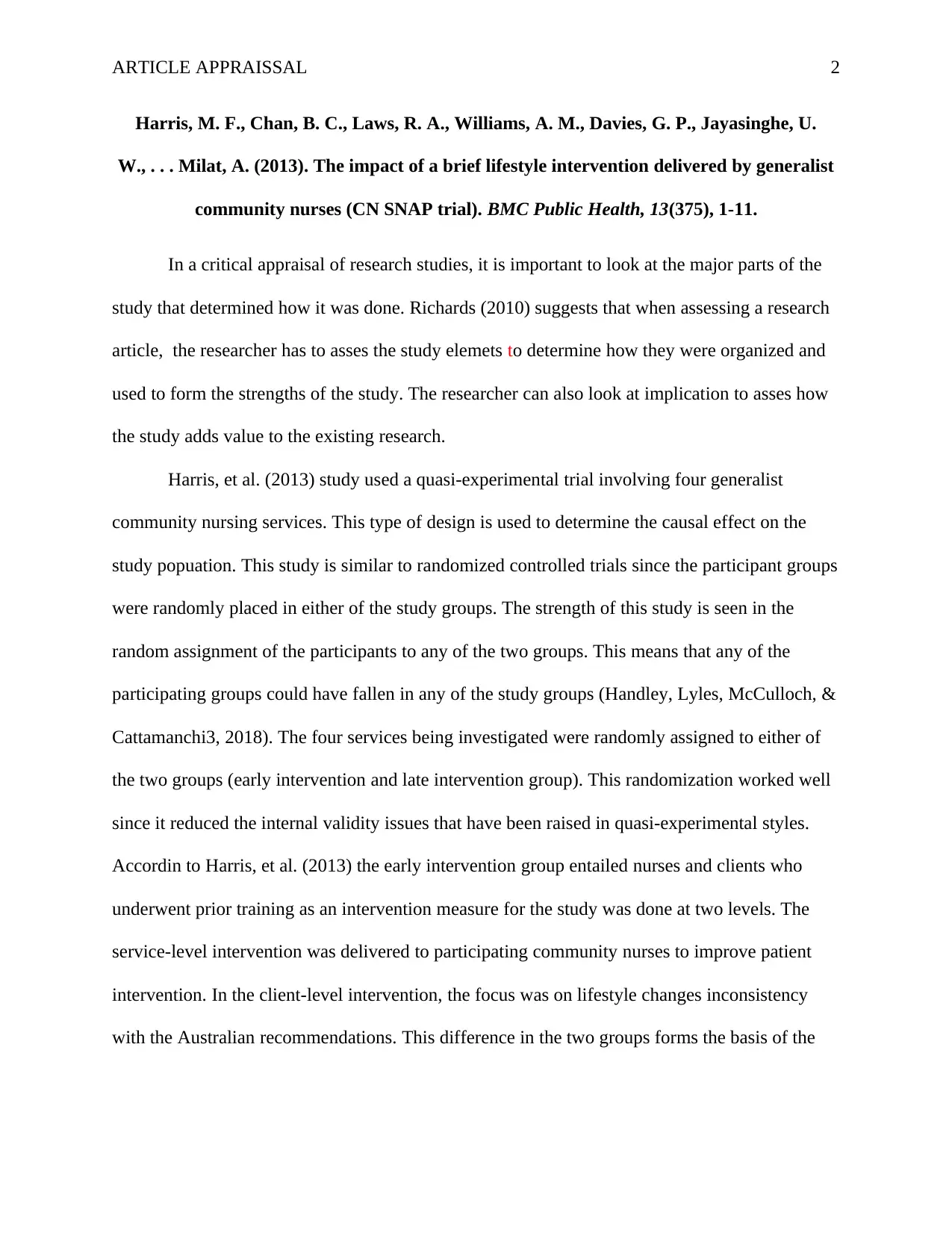
ARTICLE APPRAISSAL 2
Harris, M. F., Chan, B. C., Laws, R. A., Williams, A. M., Davies, G. P., Jayasinghe, U.
W., . . . Milat, A. (2013). The impact of a brief lifestyle intervention delivered by generalist
community nurses (CN SNAP trial). BMC Public Health, 13(375), 1-11.
In a critical appraisal of research studies, it is important to look at the major parts of the
study that determined how it was done. Richards (2010) suggests that when assessing a research
article, the researcher has to asses the study elemets to determine how they were organized and
used to form the strengths of the study. The researcher can also look at implication to asses how
the study adds value to the existing research.
Harris, et al. (2013) study used a quasi-experimental trial involving four generalist
community nursing services. This type of design is used to determine the causal effect on the
study popuation. This study is similar to randomized controlled trials since the participant groups
were randomly placed in either of the study groups. The strength of this study is seen in the
random assignment of the participants to any of the two groups. This means that any of the
participating groups could have fallen in any of the study groups (Handley, Lyles, McCulloch, &
Cattamanchi3, 2018). The four services being investigated were randomly assigned to either of
the two groups (early intervention and late intervention group). This randomization worked well
since it reduced the internal validity issues that have been raised in quasi-experimental styles.
Accordin to Harris, et al. (2013) the early intervention group entailed nurses and clients who
underwent prior training as an intervention measure for the study was done at two levels. The
service-level intervention was delivered to participating community nurses to improve patient
intervention. In the client-level intervention, the focus was on lifestyle changes inconsistency
with the Australian recommendations. This difference in the two groups forms the basis of the
Harris, M. F., Chan, B. C., Laws, R. A., Williams, A. M., Davies, G. P., Jayasinghe, U.
W., . . . Milat, A. (2013). The impact of a brief lifestyle intervention delivered by generalist
community nurses (CN SNAP trial). BMC Public Health, 13(375), 1-11.
In a critical appraisal of research studies, it is important to look at the major parts of the
study that determined how it was done. Richards (2010) suggests that when assessing a research
article, the researcher has to asses the study elemets to determine how they were organized and
used to form the strengths of the study. The researcher can also look at implication to asses how
the study adds value to the existing research.
Harris, et al. (2013) study used a quasi-experimental trial involving four generalist
community nursing services. This type of design is used to determine the causal effect on the
study popuation. This study is similar to randomized controlled trials since the participant groups
were randomly placed in either of the study groups. The strength of this study is seen in the
random assignment of the participants to any of the two groups. This means that any of the
participating groups could have fallen in any of the study groups (Handley, Lyles, McCulloch, &
Cattamanchi3, 2018). The four services being investigated were randomly assigned to either of
the two groups (early intervention and late intervention group). This randomization worked well
since it reduced the internal validity issues that have been raised in quasi-experimental styles.
Accordin to Harris, et al. (2013) the early intervention group entailed nurses and clients who
underwent prior training as an intervention measure for the study was done at two levels. The
service-level intervention was delivered to participating community nurses to improve patient
intervention. In the client-level intervention, the focus was on lifestyle changes inconsistency
with the Australian recommendations. This difference in the two groups forms the basis of the
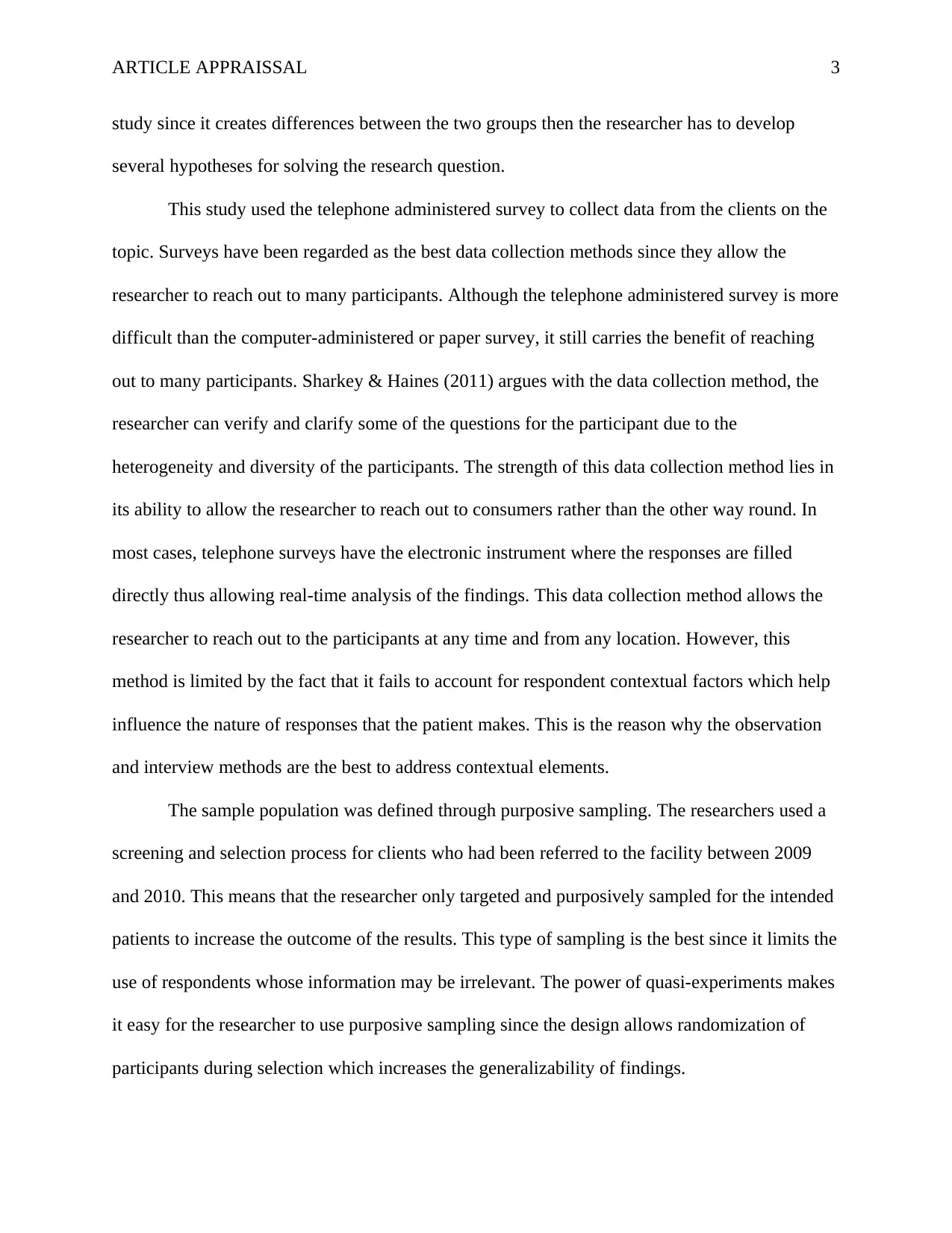
ARTICLE APPRAISSAL 3
study since it creates differences between the two groups then the researcher has to develop
several hypotheses for solving the research question.
This study used the telephone administered survey to collect data from the clients on the
topic. Surveys have been regarded as the best data collection methods since they allow the
researcher to reach out to many participants. Although the telephone administered survey is more
difficult than the computer-administered or paper survey, it still carries the benefit of reaching
out to many participants. Sharkey & Haines (2011) argues with the data collection method, the
researcher can verify and clarify some of the questions for the participant due to the
heterogeneity and diversity of the participants. The strength of this data collection method lies in
its ability to allow the researcher to reach out to consumers rather than the other way round. In
most cases, telephone surveys have the electronic instrument where the responses are filled
directly thus allowing real-time analysis of the findings. This data collection method allows the
researcher to reach out to the participants at any time and from any location. However, this
method is limited by the fact that it fails to account for respondent contextual factors which help
influence the nature of responses that the patient makes. This is the reason why the observation
and interview methods are the best to address contextual elements.
The sample population was defined through purposive sampling. The researchers used a
screening and selection process for clients who had been referred to the facility between 2009
and 2010. This means that the researcher only targeted and purposively sampled for the intended
patients to increase the outcome of the results. This type of sampling is the best since it limits the
use of respondents whose information may be irrelevant. The power of quasi-experiments makes
it easy for the researcher to use purposive sampling since the design allows randomization of
participants during selection which increases the generalizability of findings.
study since it creates differences between the two groups then the researcher has to develop
several hypotheses for solving the research question.
This study used the telephone administered survey to collect data from the clients on the
topic. Surveys have been regarded as the best data collection methods since they allow the
researcher to reach out to many participants. Although the telephone administered survey is more
difficult than the computer-administered or paper survey, it still carries the benefit of reaching
out to many participants. Sharkey & Haines (2011) argues with the data collection method, the
researcher can verify and clarify some of the questions for the participant due to the
heterogeneity and diversity of the participants. The strength of this data collection method lies in
its ability to allow the researcher to reach out to consumers rather than the other way round. In
most cases, telephone surveys have the electronic instrument where the responses are filled
directly thus allowing real-time analysis of the findings. This data collection method allows the
researcher to reach out to the participants at any time and from any location. However, this
method is limited by the fact that it fails to account for respondent contextual factors which help
influence the nature of responses that the patient makes. This is the reason why the observation
and interview methods are the best to address contextual elements.
The sample population was defined through purposive sampling. The researchers used a
screening and selection process for clients who had been referred to the facility between 2009
and 2010. This means that the researcher only targeted and purposively sampled for the intended
patients to increase the outcome of the results. This type of sampling is the best since it limits the
use of respondents whose information may be irrelevant. The power of quasi-experiments makes
it easy for the researcher to use purposive sampling since the design allows randomization of
participants during selection which increases the generalizability of findings.
⊘ This is a preview!⊘
Do you want full access?
Subscribe today to unlock all pages.

Trusted by 1+ million students worldwide
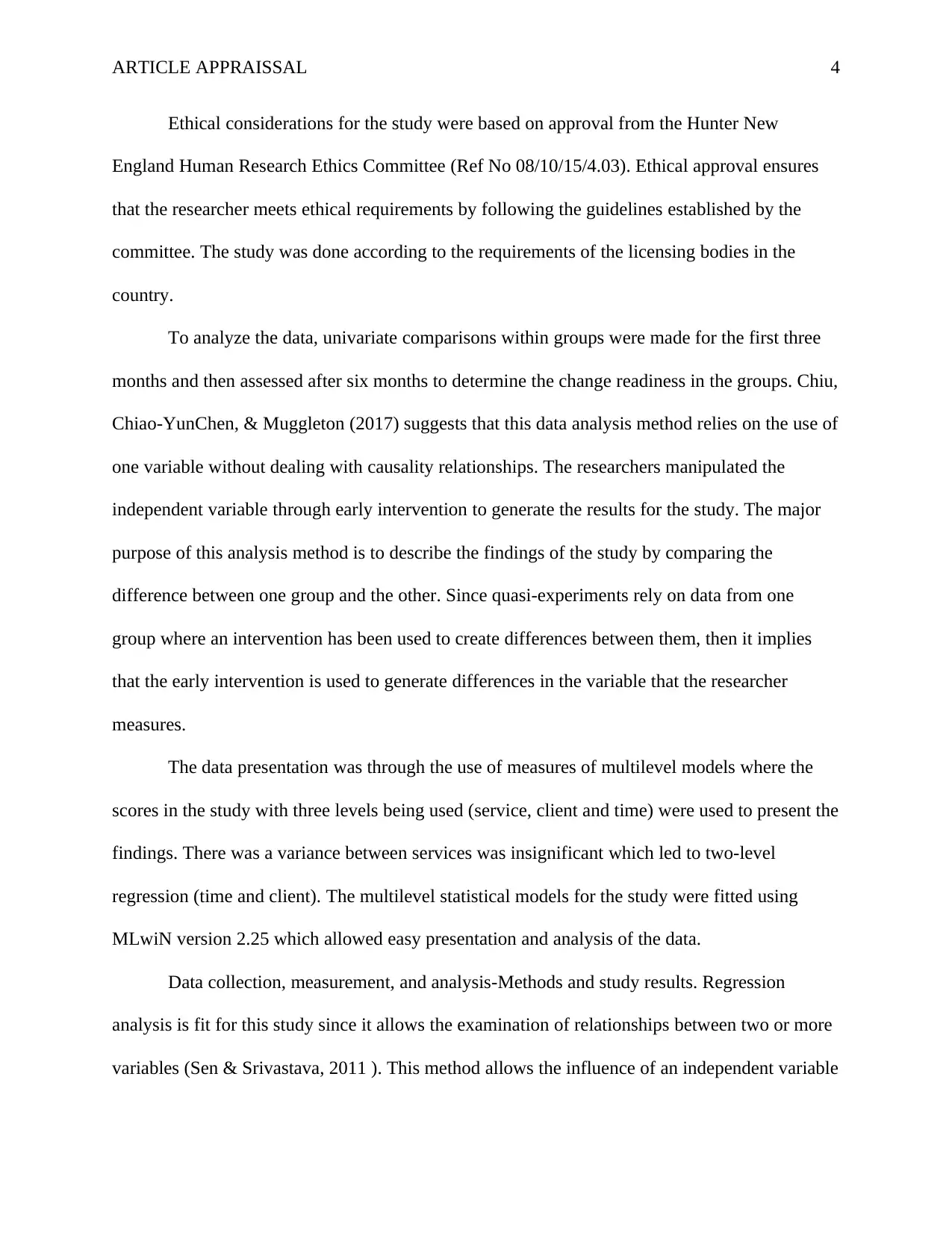
ARTICLE APPRAISSAL 4
Ethical considerations for the study were based on approval from the Hunter New
England Human Research Ethics Committee (Ref No 08/10/15/4.03). Ethical approval ensures
that the researcher meets ethical requirements by following the guidelines established by the
committee. The study was done according to the requirements of the licensing bodies in the
country.
To analyze the data, univariate comparisons within groups were made for the first three
months and then assessed after six months to determine the change readiness in the groups. Chiu,
Chiao-YunChen, & Muggleton (2017) suggests that this data analysis method relies on the use of
one variable without dealing with causality relationships. The researchers manipulated the
independent variable through early intervention to generate the results for the study. The major
purpose of this analysis method is to describe the findings of the study by comparing the
difference between one group and the other. Since quasi-experiments rely on data from one
group where an intervention has been used to create differences between them, then it implies
that the early intervention is used to generate differences in the variable that the researcher
measures.
The data presentation was through the use of measures of multilevel models where the
scores in the study with three levels being used (service, client and time) were used to present the
findings. There was a variance between services was insignificant which led to two-level
regression (time and client). The multilevel statistical models for the study were fitted using
MLwiN version 2.25 which allowed easy presentation and analysis of the data.
Data collection, measurement, and analysis-Methods and study results. Regression
analysis is fit for this study since it allows the examination of relationships between two or more
variables (Sen & Srivastava, 2011 ). This method allows the influence of an independent variable
Ethical considerations for the study were based on approval from the Hunter New
England Human Research Ethics Committee (Ref No 08/10/15/4.03). Ethical approval ensures
that the researcher meets ethical requirements by following the guidelines established by the
committee. The study was done according to the requirements of the licensing bodies in the
country.
To analyze the data, univariate comparisons within groups were made for the first three
months and then assessed after six months to determine the change readiness in the groups. Chiu,
Chiao-YunChen, & Muggleton (2017) suggests that this data analysis method relies on the use of
one variable without dealing with causality relationships. The researchers manipulated the
independent variable through early intervention to generate the results for the study. The major
purpose of this analysis method is to describe the findings of the study by comparing the
difference between one group and the other. Since quasi-experiments rely on data from one
group where an intervention has been used to create differences between them, then it implies
that the early intervention is used to generate differences in the variable that the researcher
measures.
The data presentation was through the use of measures of multilevel models where the
scores in the study with three levels being used (service, client and time) were used to present the
findings. There was a variance between services was insignificant which led to two-level
regression (time and client). The multilevel statistical models for the study were fitted using
MLwiN version 2.25 which allowed easy presentation and analysis of the data.
Data collection, measurement, and analysis-Methods and study results. Regression
analysis is fit for this study since it allows the examination of relationships between two or more
variables (Sen & Srivastava, 2011 ). This method allows the influence of an independent variable
Paraphrase This Document
Need a fresh take? Get an instant paraphrase of this document with our AI Paraphraser
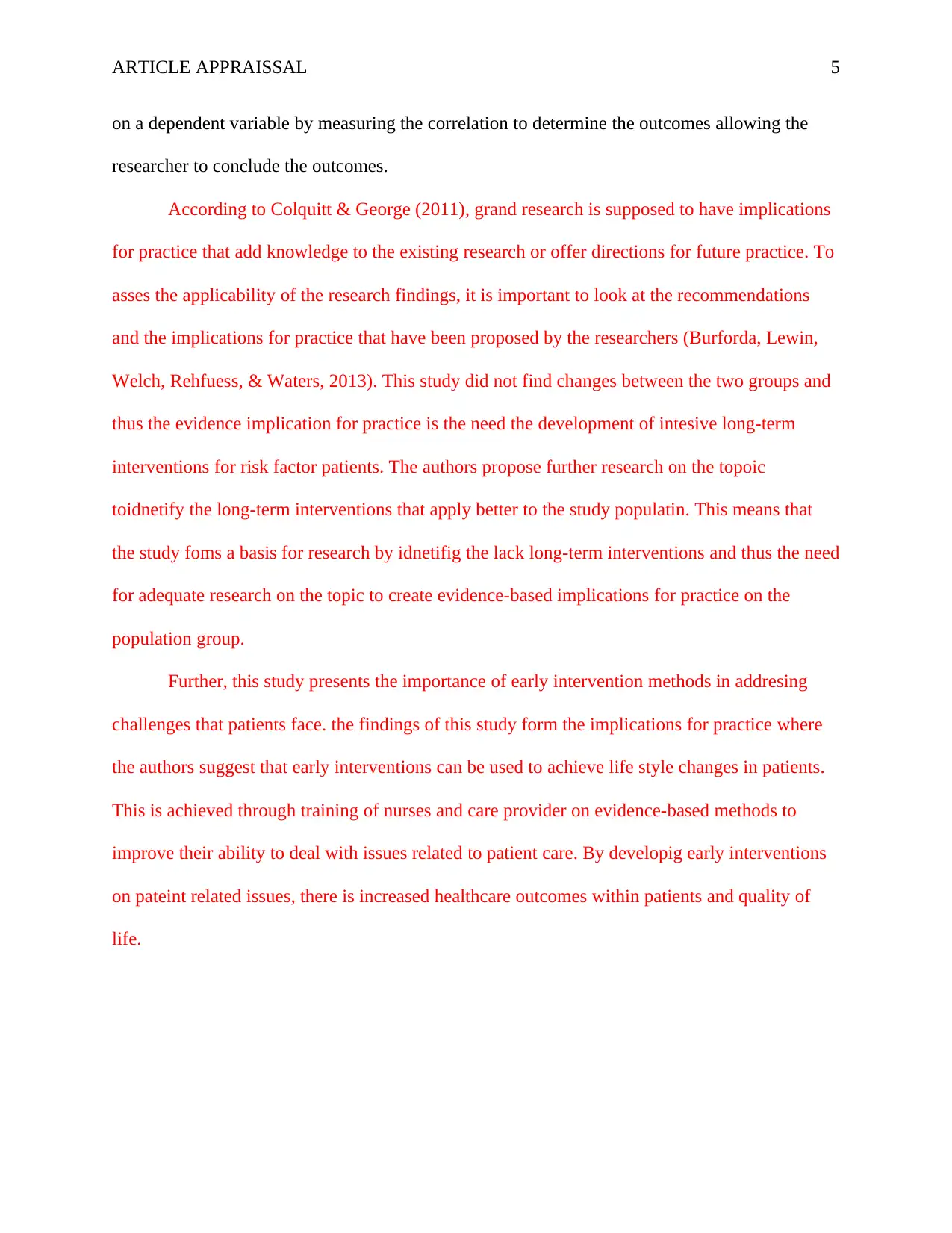
ARTICLE APPRAISSAL 5
on a dependent variable by measuring the correlation to determine the outcomes allowing the
researcher to conclude the outcomes.
According to Colquitt & George (2011), grand research is supposed to have implications
for practice that add knowledge to the existing research or offer directions for future practice. To
asses the applicability of the research findings, it is important to look at the recommendations
and the implications for practice that have been proposed by the researchers (Burforda, Lewin,
Welch, Rehfuess, & Waters, 2013). This study did not find changes between the two groups and
thus the evidence implication for practice is the need the development of intesive long-term
interventions for risk factor patients. The authors propose further research on the topoic
toidnetify the long-term interventions that apply better to the study populatin. This means that
the study foms a basis for research by idnetifig the lack long-term interventions and thus the need
for adequate research on the topic to create evidence-based implications for practice on the
population group.
Further, this study presents the importance of early intervention methods in addresing
challenges that patients face. the findings of this study form the implications for practice where
the authors suggest that early interventions can be used to achieve life style changes in patients.
This is achieved through training of nurses and care provider on evidence-based methods to
improve their ability to deal with issues related to patient care. By developig early interventions
on pateint related issues, there is increased healthcare outcomes within patients and quality of
life.
on a dependent variable by measuring the correlation to determine the outcomes allowing the
researcher to conclude the outcomes.
According to Colquitt & George (2011), grand research is supposed to have implications
for practice that add knowledge to the existing research or offer directions for future practice. To
asses the applicability of the research findings, it is important to look at the recommendations
and the implications for practice that have been proposed by the researchers (Burforda, Lewin,
Welch, Rehfuess, & Waters, 2013). This study did not find changes between the two groups and
thus the evidence implication for practice is the need the development of intesive long-term
interventions for risk factor patients. The authors propose further research on the topoic
toidnetify the long-term interventions that apply better to the study populatin. This means that
the study foms a basis for research by idnetifig the lack long-term interventions and thus the need
for adequate research on the topic to create evidence-based implications for practice on the
population group.
Further, this study presents the importance of early intervention methods in addresing
challenges that patients face. the findings of this study form the implications for practice where
the authors suggest that early interventions can be used to achieve life style changes in patients.
This is achieved through training of nurses and care provider on evidence-based methods to
improve their ability to deal with issues related to patient care. By developig early interventions
on pateint related issues, there is increased healthcare outcomes within patients and quality of
life.
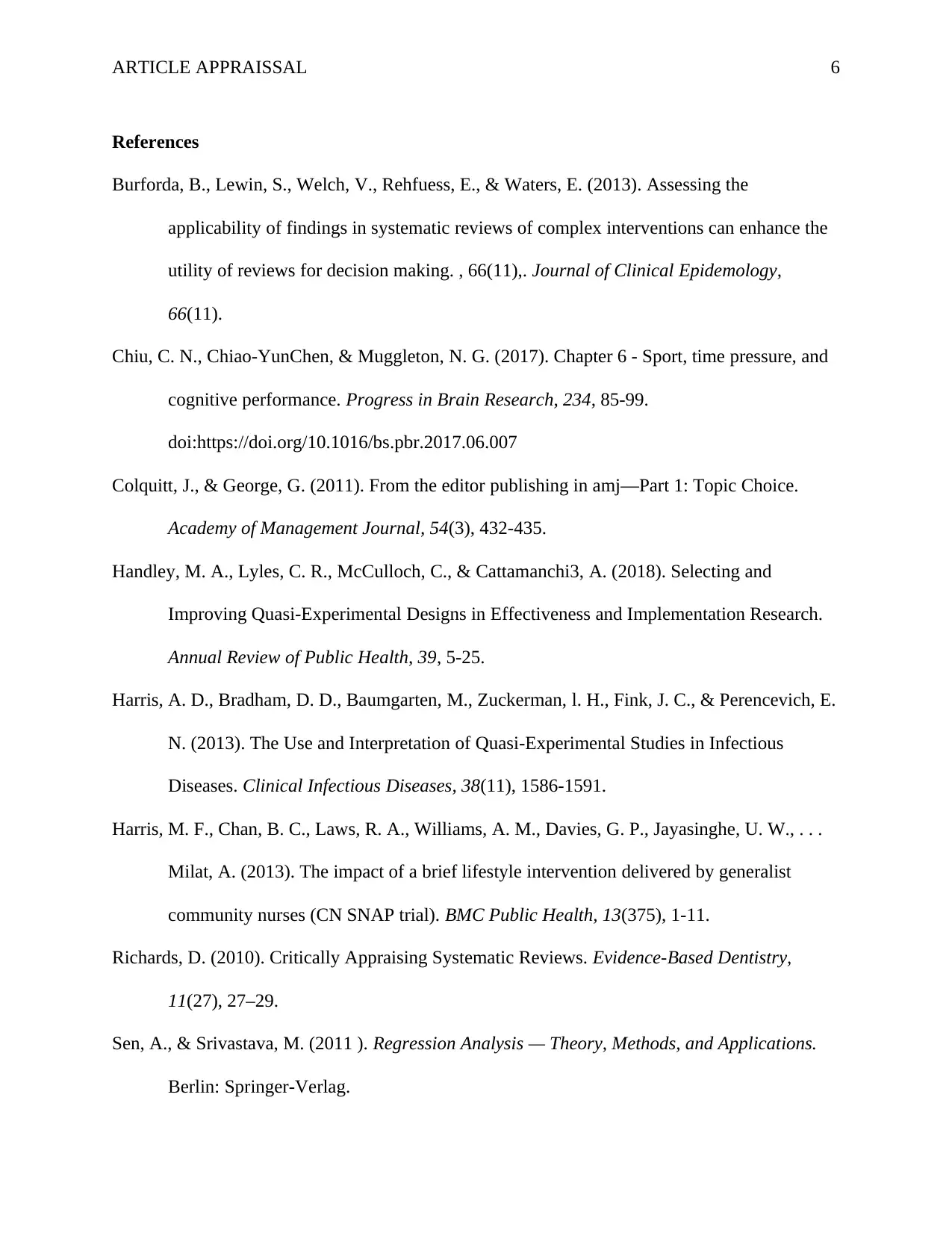
ARTICLE APPRAISSAL 6
References
Burforda, B., Lewin, S., Welch, V., Rehfuess, E., & Waters, E. (2013). Assessing the
applicability of findings in systematic reviews of complex interventions can enhance the
utility of reviews for decision making. , 66(11),. Journal of Clinical Epidemology,
66(11).
Chiu, C. N., Chiao-YunChen, & Muggleton, N. G. (2017). Chapter 6 - Sport, time pressure, and
cognitive performance. Progress in Brain Research, 234, 85-99.
doi:https://doi.org/10.1016/bs.pbr.2017.06.007
Colquitt, J., & George, G. (2011). From the editor publishing in amj—Part 1: Topic Choice.
Academy of Management Journal, 54(3), 432-435.
Handley, M. A., Lyles, C. R., McCulloch, C., & Cattamanchi3, A. (2018). Selecting and
Improving Quasi-Experimental Designs in Effectiveness and Implementation Research.
Annual Review of Public Health, 39, 5-25.
Harris, A. D., Bradham, D. D., Baumgarten, M., Zuckerman, l. H., Fink, J. C., & Perencevich, E.
N. (2013). The Use and Interpretation of Quasi-Experimental Studies in Infectious
Diseases. Clinical Infectious Diseases, 38(11), 1586-1591.
Harris, M. F., Chan, B. C., Laws, R. A., Williams, A. M., Davies, G. P., Jayasinghe, U. W., . . .
Milat, A. (2013). The impact of a brief lifestyle intervention delivered by generalist
community nurses (CN SNAP trial). BMC Public Health, 13(375), 1-11.
Richards, D. (2010). Critically Appraising Systematic Reviews. Evidence-Based Dentistry,
11(27), 27–29.
Sen, A., & Srivastava, M. (2011 ). Regression Analysis — Theory, Methods, and Applications.
Berlin: Springer-Verlag.
References
Burforda, B., Lewin, S., Welch, V., Rehfuess, E., & Waters, E. (2013). Assessing the
applicability of findings in systematic reviews of complex interventions can enhance the
utility of reviews for decision making. , 66(11),. Journal of Clinical Epidemology,
66(11).
Chiu, C. N., Chiao-YunChen, & Muggleton, N. G. (2017). Chapter 6 - Sport, time pressure, and
cognitive performance. Progress in Brain Research, 234, 85-99.
doi:https://doi.org/10.1016/bs.pbr.2017.06.007
Colquitt, J., & George, G. (2011). From the editor publishing in amj—Part 1: Topic Choice.
Academy of Management Journal, 54(3), 432-435.
Handley, M. A., Lyles, C. R., McCulloch, C., & Cattamanchi3, A. (2018). Selecting and
Improving Quasi-Experimental Designs in Effectiveness and Implementation Research.
Annual Review of Public Health, 39, 5-25.
Harris, A. D., Bradham, D. D., Baumgarten, M., Zuckerman, l. H., Fink, J. C., & Perencevich, E.
N. (2013). The Use and Interpretation of Quasi-Experimental Studies in Infectious
Diseases. Clinical Infectious Diseases, 38(11), 1586-1591.
Harris, M. F., Chan, B. C., Laws, R. A., Williams, A. M., Davies, G. P., Jayasinghe, U. W., . . .
Milat, A. (2013). The impact of a brief lifestyle intervention delivered by generalist
community nurses (CN SNAP trial). BMC Public Health, 13(375), 1-11.
Richards, D. (2010). Critically Appraising Systematic Reviews. Evidence-Based Dentistry,
11(27), 27–29.
Sen, A., & Srivastava, M. (2011 ). Regression Analysis — Theory, Methods, and Applications.
Berlin: Springer-Verlag.
⊘ This is a preview!⊘
Do you want full access?
Subscribe today to unlock all pages.

Trusted by 1+ million students worldwide

ARTICLE APPRAISSAL 7
Sharkey, J. R., & Haines, P. S. (2011). The Feasibility of Using a Telephone-Administered
Survey for Determining Nutritional Service Needs of Noninstitutionalized Older Adults
in Rural Areas: Time and Costs. The Gerontologist, 4(1), 546–552.
doi:https://doi.org/10.1093/geront/41.4.546
Sharkey, J. R., & Haines, P. S. (2011). The Feasibility of Using a Telephone-Administered
Survey for Determining Nutritional Service Needs of Noninstitutionalized Older Adults
in Rural Areas: Time and Costs. The Gerontologist, 4(1), 546–552.
doi:https://doi.org/10.1093/geront/41.4.546
1 out of 7
Related Documents
Your All-in-One AI-Powered Toolkit for Academic Success.
+13062052269
info@desklib.com
Available 24*7 on WhatsApp / Email
![[object Object]](/_next/static/media/star-bottom.7253800d.svg)
Unlock your academic potential
Copyright © 2020–2025 A2Z Services. All Rights Reserved. Developed and managed by ZUCOL.





